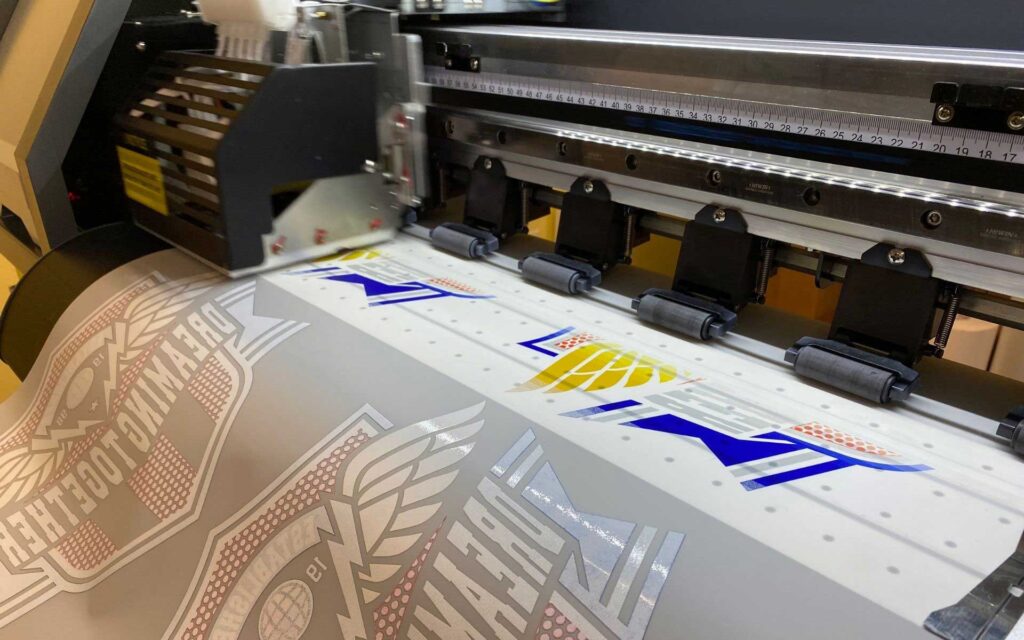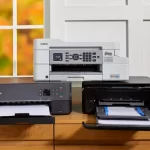What is a Sublimation Printer?
Sublimation printing is a revolutionary technology that has taken the customization and printing industry by storm. But what exactly is a sublimation printer? It’s a specialized device designed to transfer designs onto various materials using heat and pressure. Unlike traditional printers that print directly on the surface, sublimation printers create vibrant, long-lasting prints by embedding ink into the material itself.
The Science Behind Sublimation
Sublimation printing relies on a chemical process where solid ink transforms directly into a gas without becoming liquid. This gas penetrates the material’s surface and bonds at a molecular level, creating a smooth, vivid finish. The result? Stunning prints that feel like a part of the material, rather than sitting on top of it.
Differences from Traditional Printing Methods
Compared to inkjet or laser printing, sublimation offers unparalleled durability. The designs are resistant to fading, peeling, or cracking, even after multiple washes or prolonged exposure to sunlight. Additionally, sublimation allows full-color, edge-to-edge designs, making it ideal for intricate patterns and vibrant artwork.
How Does a Sublimation Printer Work?
Sublimation printers operate through a fascinating blend of technology and chemistry. Let’s dive into the step-by-step process to understand how it all comes together.
Step-by-Step Sublimation Printing Process
- Printing the Image: Start by creating a design using specialized sublimation inks and transferring it onto sublimation paper. These inks are unique because they turn into gas when exposed to high heat.
- Heat Transfer Process: Place the sublimation paper onto the substrate (the item you’re printing on), and use a heat press to apply pressure and heat. This step transforms the solid ink into gas.
- Binding the Ink to the Material: The gaseous ink embeds itself into the substrate’s surface, permanently bonding with it. Once cooled, the design is part of the material.
Key Components of a Sublimation Printer
A sublimation printer consists of:
- Sublimation Inks: These specially formulated inks convert to gas under heat.
- Sublimation Paper: Transfers the design accurately.
- Advanced Printing Mechanism: Ensures precision and color vibrancy.
Advantages of Sublimation Printing
Sublimation printing offers numerous benefits that make it a preferred choice for personal and professional use.
High-Quality Output
The colors are rich, vibrant, and photo-realistic. Whether printing on a t-shirt or ceramic mug, sublimation ensures exceptional detail.
Durability and Fade Resistance
Unlike other printing methods, sublimation designs don’t fade or peel over time. The ink is embedded in the material, providing unmatched durability.
Versatility of Materials and Designs
From fabric and ceramics to metals and plastics, sublimation works on a wide range of substrates. It also allows for highly customizable, edge-to-edge designs.
Common Applications of Sublimation Printing
Sublimation printing isn’t limited to just one industry; its versatility has made it a game-changer across various domains.
Personalized Apparel and Accessories
From custom t-shirts to tote bags, sublimation printing creates unique, wearable designs perfect for gifts, branding, or self-expression.
Custom Mugs and Tumblers
One of the most popular uses of sublimation is creating personalized drinkware. Designs are dishwasher-safe and retain their vibrancy for years.
Home Décor and Signage
Transform plain spaces into artistic hubs with sublimation-printed cushions, curtains, and wall art. Even business signage can benefit from its high-quality finish.
Corporate Branding Products
Promotional products like pens, mousepads, and keychains are often sublimated to showcase company logos in a professional yet eye-catching way.
Sublimation Printing vs. Other Printing Techniques
Choosing the right printing method can be tricky. Here’s how sublimation stacks up against other popular techniques.
Sublimation vs. Inkjet Printing
Inkjet is more affordable but lacks the durability and quality of sublimation. While inkjet prints may fade or smear, sublimation prints stay vibrant.
Sublimation vs. Heat Transfer Vinyl (HTV)
HTV involves layering vinyl on a surface, which can crack or peel. Sublimation, on the other hand, embeds the design, ensuring longevity.
Sublimation vs. Screen Printing
Screen printing is ideal for bulk orders but is limited in color range and detail. Sublimation shines for custom, intricate, or one-off designs.
Essential Equipment for Sublimation Printing
If you’re diving into the world of sublimation printing, having the right tools is essential. Here’s a breakdown of the equipment needed to get started.
Sublimation Printer and Inks
The most critical tool is, of course, a sublimation printer. Popular models like the Sawgrass and Epson EcoTank series are excellent choices for beginners and professionals alike. These printers use specialized sublimation inks that convert from solid to gas under heat.
Heat Press Machine
A heat press is indispensable for sublimation printing. It ensures the ink transfers from the sublimation paper onto the material evenly and effectively. Heat presses come in various sizes and shapes depending on your needs. For example:
- Flat heat presses for clothing or flat surfaces.
- Mug presses for cylindrical items like cups.
Substrate Materials
Not all materials are suitable for sublimation. Sublimation works best on polyester-coated surfaces or fabrics. Common substrates include:
- Polyester t-shirts.
- Ceramic mugs with sublimation coating.
- Aluminum plates and photo panels.
Accessories for Better Results
Additional tools can make your work smoother and more professional:
- Heat-resistant tape to secure the sublimation paper during transfer.
- Protective sheets to prevent ink bleeding.
- A lint roller for prepping fabric surfaces.
Tips for Beginners in Sublimation Printing
Starting sublimation printing can feel overwhelming, but with the right guidance, you’ll master it in no time. Here are some pro tips to set you on the path to success.
Choosing the Right Equipment
Invest in a high-quality sublimation printer and heat press. Cheaper alternatives might seem tempting, but they often lack the precision and durability needed for professional results.
Understanding Color Management
Color management is vital to ensure your designs look as vibrant as they do on screen. Use ICC profiles (color profiles specific to your printer and inks) to maintain accurate color representation during printing.
Best Practices for Durability
- Always use materials designed for sublimation.
- Pre-press fabrics to remove moisture and wrinkles before printing.
- Allow the substrate to cool completely before handling it to avoid smudges.
Limitations of Sublimation Printing
While sublimation printing offers many benefits, it does come with some limitations.
Material Restrictions
Sublimation only works on polyester-coated materials or fabrics with high polyester content. This can be a limitation if you’re working with cotton or other natural fibers.
Cost Considerations
Sublimation equipment and supplies, especially high-quality inks and printers, can be expensive. However, the long-term durability and quality of the prints often justify the investment.
Initial Learning Curve
Beginners may find the process tricky at first, especially when managing heat settings and achieving precise colors. Practice and experimentation are essential to overcome this hurdle.
Maintenance and Troubleshooting of Sublimation Printers
To keep your sublimation printer in top condition and ensure consistent results, regular maintenance is crucial.
Regular Cleaning Tips
Sublimation printers require frequent cleaning to avoid ink clogs. Use the printer’s built-in maintenance settings and clean the print heads as needed.
Common Issues and How to Fix Them
- Banding on prints: This often occurs when the ink nozzles are clogged. Perform a nozzle check and clean the print heads.
- Blurry or faded prints: Ensure the sublimation paper is correctly aligned, and the heat press is set to the appropriate temperature.
- Uneven transfers: This might be due to uneven pressure or improper substrate preparation. Always check your heat press setup.
How to Start a Sublimation Printing Business
Sublimation printing is not just a creative outlet; it can also be a lucrative business. Here’s how to kickstart your entrepreneurial journey.
Market Research and Niche Selection
Identify your target audience and niche. Whether it’s personalized gifts, corporate branding, or custom apparel, focusing on a specific niche helps you stand out.
Setting Up a Budget and Workspace
Calculate the costs of equipment, supplies, and workspace setup. Start small with a home-based setup, and scale as your business grows.
Marketing and Scaling Your Business
Use social media platforms like Instagram and Pinterest to showcase your designs. Partner with local businesses or participate in craft fairs to expand your reach. As demand grows, consider upgrading your equipment or hiring staff.
Best Sublimation Printers in 2024
Choosing the right sublimation printer can make or break your printing experience. Here are some top picks for 2024.
Epson EcoTank Series
Known for its affordability and reliability, the Epson EcoTank series is a favorite among beginners. Its refillable ink tanks reduce running costs significantly.
Sawgrass Sublimation Printers
Sawgrass printers are industry leaders in sublimation. With their excellent color accuracy and user-friendly software, they’re perfect for professional-grade printing.
Budget-Friendly Options
For those on a tight budget, converted inkjet printers (like older Epson models) can be an affordable entry point into sublimation printing. However, these may lack some of the features of dedicated sublimation printers.
Sustainability and Eco-Friendliness of Sublimation Printing
With growing environmental concerns, it’s essential to understand the sustainability aspects of sublimation printing.
Environmental Impact of Sublimation Inks
While sublimation inks are generally safe, they are not biodegradable. Manufacturers are working on eco-friendly ink alternatives to reduce environmental impact.
Recycling Substrate Materials
Many sublimation substrates, like polyester fabrics, can be recycled. Encourage your customers to reuse or recycle items when possible to promote sustainability.
Future Trends in Sublimation Printing
As technology evolves, so does the potential of sublimation printing. Here are some exciting trends to watch out for.
Innovations in Printer Technology
Expect faster, more efficient sublimation printers with enhanced color accuracy and energy-saving features.
Expanding Materials for Sublimation
Researchers are developing new substrates compatible with sublimation, including eco-friendly materials and blends that cater to a broader range of industries.
FAQs
1. What is the difference between sublimation printing and heat transfer?
Sublimation embeds the ink into the material, making it more durable, while heat transfer applies a design on the surface, which may peel or fade over time.
2. Can sublimation printing be done on cotton?
No, sublimation works best on polyester or polyester-coated materials. For cotton, you’d need a special coating or alternative printing methods.
3. How long do sublimation prints last?
Sublimation prints are highly durable and can last for years without fading, even after multiple washes.
4. Is sublimation printing expensive to start?
The initial investment can be high, especially for equipment and inks, but the long-term benefits and quality often outweigh the costs.
5. Can I convert a regular printer into a sublimation printer?
Yes, certain inkjet printers, like some Epson models, can be converted for sublimation use. However, it’s not always as reliable as dedicated sublimation printers.
Conclusion
Sublimation printing is a versatile, high-quality printing method that opens the door to endless creative and business opportunities. Whether you’re looking to customize products for personal use or build a thriving business, understanding the process, equipment, and limitations will set you up for success. With the right tools and a bit of practice, sublimation printing can help you turn your creative ideas into reality.



